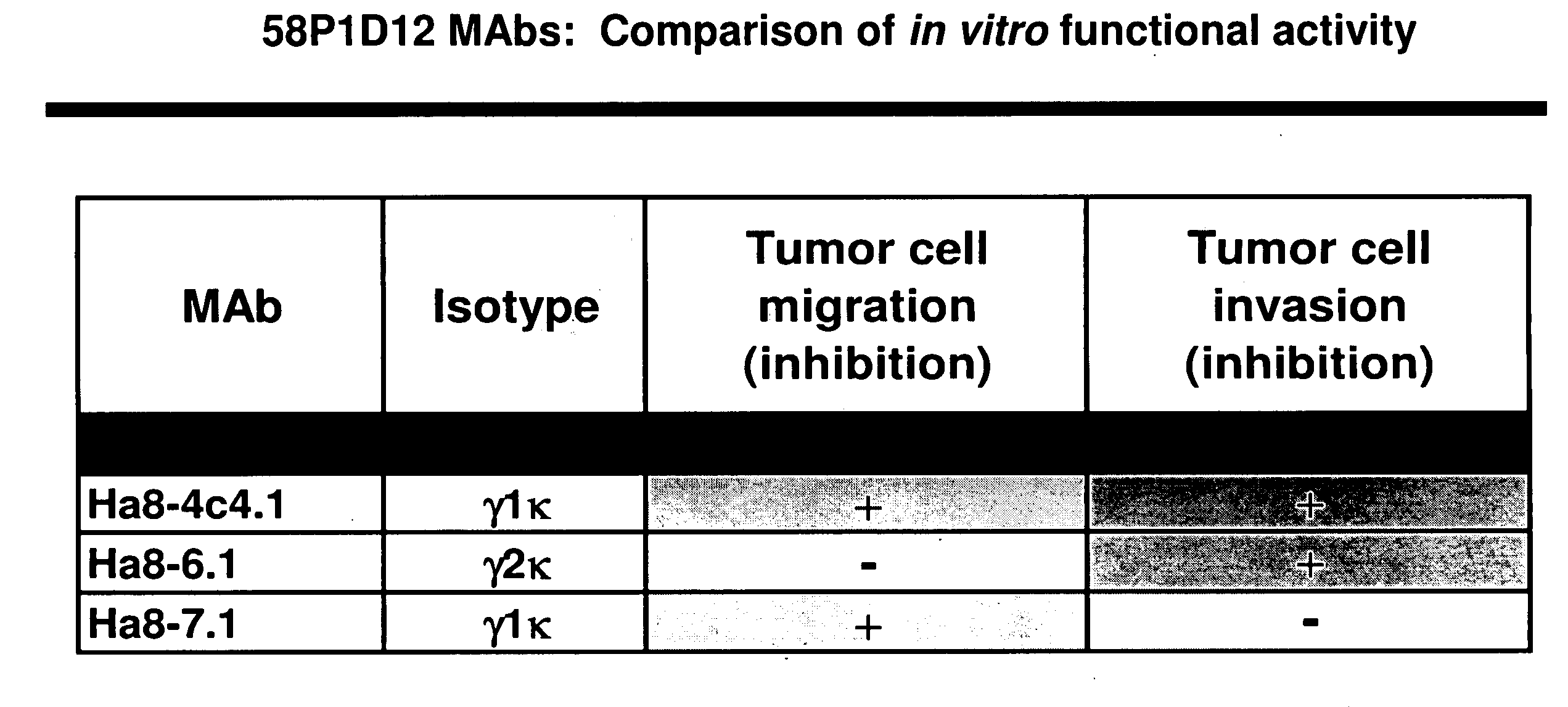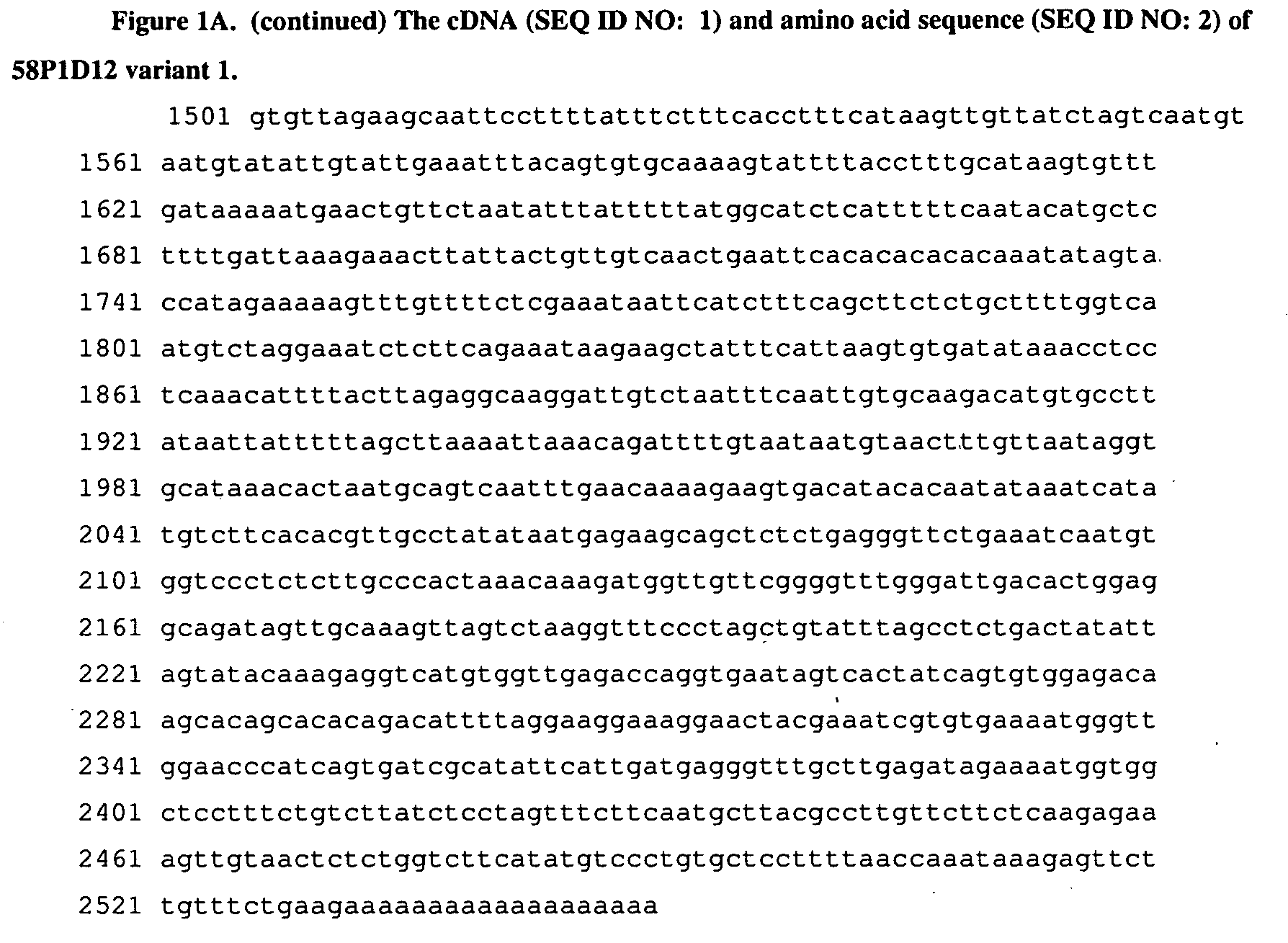Antibodies and related molecules that bind to 58p1d12 proteins
a technology of antibodies and related molecules, applied in the field of antibodies, can solve the problems of ineffective treatment for many patients, undesirable consequences, and still no effective treatment for metastatic prostate cancer, and achieve the effects of inhibiting transcription, translation, processing or function, and inhibiting production or function
- Summary
- Abstract
- Description
- Claims
- Application Information
AI Technical Summary
Benefits of technology
Problems solved by technology
Method used
Image
Examples
example 1
The 58P1D12 Antigen
[0533]The novel 58P1D12 gene sequence was discovered using Suppression Subtractive Hybridization (SSH) methods known in the art. The 58P1D12 SSH sequence of 427 bp was identified from a LAPC xenograft SSH experiment using standard methods. A full length cDNA clone for 58P1D12 was isolated from a LAPC-9 AD library. The cDNA (clone 2) is 2550 bp in length and encodes a 273 amino acid ORF (See, FIG. 1A). 58P1D12 v.1 exhibits 100% homology to human chondrolectin. For further reference see, U.S. Pat. No. 7,087,718 (Agensys, Inc., Santa Monica, Calif.) and U.S. patent publication US2005 / 0136435 (Agensys, Inc., Santa Monica, Calif.).
example 2
Splice Variants of 58P1D12
[0534]Splice variants are variants of mature mRNA from the same gene which arise by alternative transcription or alternative splicing. Alternative transcripts are transcripts from the same gene but start transcription at different points. Splice variants are mRNA variants spliced differently from the same transcript. In eukaryotes, when a multi-exon gene is transcribed from genomic DNA, the initial RNA is spliced to produce functional mRNA, which has only exons and is used for translation into an amino acid sequence. Accordingly, a given gene can have zero to many alternative transcripts and each transcript can have zero to many splice variants. Each transcript variant has a unique exon makeup, and can have different coding and / or non-coding (5′ or 3′ end) portions, from the original transcript. Transcript variants can code for similar or different proteins with the same or a similar function or can encode proteins with different functions, and can be expre...
example 3
Single Nucleotide Polymorphisms of 58P1D12
[0540]A Single Nucleotide Polymorphism (SNP) is a single base pair variation in a nucleotide sequence at a specific location. At any given point of the genome, there are four possible nucleotide base pairs: A / T, C / G, G / C and T / A. Genotype refers to the specific base pair sequence of one or more locations in the genome of an individual. Haplotype refers to the base pair sequence of more than one location on the same DNA molecule (or the same chromosome in higher organisms), often in the context of one gene or in the context of several tightly linked genes. SNP that occurs on a cDNA is called cSNP. This cSNP may change amino acids of the protein encoded by the gene and thus change the functions of the protein. Some SNP cause inherited diseases; others contribute to quantitative variations in phenotype and reactions to environmental factors including diet and drugs among individuals. Therefore, SNP and / or combinations of alleles (called haploty...
PUM
| Property | Measurement | Unit |
|---|---|---|
| Fraction | aaaaa | aaaaa |
| Current | aaaaa | aaaaa |
| Current | aaaaa | aaaaa |
Abstract
Description
Claims
Application Information
 Login to View More
Login to View More - R&D
- Intellectual Property
- Life Sciences
- Materials
- Tech Scout
- Unparalleled Data Quality
- Higher Quality Content
- 60% Fewer Hallucinations
Browse by: Latest US Patents, China's latest patents, Technical Efficacy Thesaurus, Application Domain, Technology Topic, Popular Technical Reports.
© 2025 PatSnap. All rights reserved.Legal|Privacy policy|Modern Slavery Act Transparency Statement|Sitemap|About US| Contact US: help@patsnap.com



